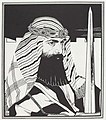Ephraim Moses Lilien
Ephraim Moses Lilien | |
|---|---|
 | |
| Born | Maurycy Lilien 23 May 1874 Drohobycz, Galicia, Austro-Hungarian Empire (modern Drohobych, Ukraine) |
| Died | 18 July 1925 (age 51) Badenweiler, Republic of Baden, Weimar Republic |
| Education | Academy of Arts in Kraków Academy of Fine Arts Vienna |
| Known for | Illustrator and print-maker |
| Movement | Bezalel school |
Maurycy "Ephraim Moses" Lilien (Polish: [mawˈrɨt͡sɨ ˈliljɛn]; Hebrew: אפרים משה ליליין; 23 May 1874 – 18 July 1925) was an art nouveau illustrator and printmaker particularly noted for his art on Jewish themes and his influence on the Bezalel school art movement. He is sometimes called the "first Zionist artist."[1]
Biography
Maurycy Lilien was born in 1874 in Drohobycz, Galicia,[2] then in the Austro-Hungarian Empire. In 1889–1893, Lilien learned painting and graphic techniques at the Academy of Arts in Kraków. He studied under Polish painter Jan Matejko from 1890 to 1892.[citation needed]
As a member of the Zionist Movement, Lilien traveled to Ottoman Palestine several times between 1906 and 1918.[3]
Lilien attended the Fifth Zionist Congress, held in Basel, as a member of the Democratic Fraction, an opposition group that supported the development of secular national culture.[4] In 1905, at the Seventh Zionist Congress, in Basel, he, along with Boris Schatz, became a member of a committee formed to help establish the Bezalel Art School.[2] As part of that work he accompanied Schatz to Jerusalem.[1]
Art career
Lilien was one of the two artists to accompany Boris Schatz to what is now Israel in 1906 for the purpose of establishing Bezalel Academy of Arts and Design, and taught the school's first class in 1906. Although his stay in the country was short-lived, he left his indelible stamp on the creation of an Eretz Israel style, placing biblical subjects in the Zionist context and oriental settings, conceived in an idealized Western design. In the first two decades of the century, Lilien's work served as a model for the Bezalel group.
Lilien is known for his famous photographic portrait of Theodor Herzl. He often used Herzl as a model, considering his features a perfect representation of the "New Jew."[5] In 1896, he received an award for photography from the avant-garde magazine Jugend. Lilien illustrated several books. In 1923, an exhibition of his work opened in New York.[3]
Lilien's illustrated books include Juda (1900), Biblically themed poetry by Lilien's Christian friend, Börries Freiherr von Münchhausen, and Lieder des Ghetto (Songs of the Ghetto) (1903), Yiddish poems by Morris Rosenfeld translated into German.
Lilien died in Badenweiler, Germany in 1925. A street in the Nayot neighborhood of Jerusalem is named for him.
Gallery
-
 "Sunflower" (Sonnenblume), Jugend, Berlin, 1893
"Sunflower" (Sonnenblume), Jugend, Berlin, 1893 -

-
 "The Queen of Sabbath", from Juda, Berlin, 1900-1
"The Queen of Sabbath", from Juda, Berlin, 1900-1 -
!["The Silent Song" from Juda, 1900–1.[6]](//upload.wikimedia.org/wikipedia/commons/thumb/1/17/Juda_11.jpg/91px-Juda_11.jpg) "The Silent Song" from Juda, 1900–1.[6]
"The Silent Song" from Juda, 1900–1.[6] -
!['May our eyes behold your return in mercy to Zion, Fifth Zionist Congress souvenir, Basel, 1901.[7]](//upload.wikimedia.org/wikipedia/commons/thumb/d/d9/May_our_eyes_behold_your_return_in_mercy_to_Zion.jpg/120px-May_our_eyes_behold_your_return_in_mercy_to_Zion.jpg) 'May our eyes behold your return in mercy to Zion, Fifth Zionist Congress souvenir, Basel, 1901.[7]
'May our eyes behold your return in mercy to Zion, Fifth Zionist Congress souvenir, Basel, 1901.[7] -
 Theodor Herzl in Basel, 1901
Theodor Herzl in Basel, 1901 -
 Ost und West, 1903
Ost und West, 1903 -
![Homage to the victims of the first Chișinău pogrom, 1903.[8]](//upload.wikimedia.org/wikipedia/commons/thumb/4/4e/Kishinev_Martyrs.jpg/85px-Kishinev_Martyrs.jpg) Homage to the victims of the first Chișinău pogrom, 1903.[8]
Homage to the victims of the first Chișinău pogrom, 1903.[8] -
 Jewish child from Lieder des Ghetto, 1903
Jewish child from Lieder des Ghetto, 1903 -
 "Zion", Lieder des Ghetto, 1903
"Zion", Lieder des Ghetto, 1903 -
 Ex libris Boris Schatz, 1905
Ex libris Boris Schatz, 1905 -
 Emblem of the Bezalel Academy of Arts and Design, Jerusalem, 1906
Emblem of the Bezalel Academy of Arts and Design, Jerusalem, 1906 -
 An Allegorical Wedding: Sketch for a carpet Triptych (from right to left): Exile, Marriage, Redemption, 1906
An Allegorical Wedding: Sketch for a carpet Triptych (from right to left): Exile, Marriage, Redemption, 1906 -
 Portrait, photograph, 1906
Portrait, photograph, 1906 -
 Joshua, 1908
Joshua, 1908 -
 Abraham, 1908
Abraham, 1908 -
![Balaam, [1908]](//upload.wikimedia.org/wikipedia/commons/thumb/a/ab/Bileam_and_his_she-ass.jpg/120px-Bileam_and_his_she-ass.jpg) Balaam, [1908]
Balaam, [1908] -
![Dybbuk, [1908]](//upload.wikimedia.org/wikipedia/commons/thumb/2/22/Dybbuk.jpg/120px-Dybbuk.jpg) Dybbuk, [1908]
Dybbuk, [1908] - Kotel (Western Wall), 1910
-
 In the Library, engraving, 1915
In the Library, engraving, 1915 -

-
 Learning Talmud, engraving, 1915
Learning Talmud, engraving, 1915 -
 Figures, photograph, c. 1918
Figures, photograph, c. 1918 -
 The Samaritan, engraving, c. 1920
The Samaritan, engraving, c. 1920
References
- ^ a b Haim Finkelstein, Lilien and Zionism Archived 2004-04-14 at the Wayback Machine
- ^ a b Werner, Alfred; Radjai-Ordoubadi, Jihan (2007). "Lilien, Ephraim Moses". In Berenbaum, Michael; Skolnik, Fred (eds.). Encyclopaedia Judaica. Vol. 13 (2nd ed.). Detroit: Macmillan Reference. p. 14. ISBN 978-0-02-866097-4 – via Encyclopedia.com.
- ^ a b On Ephraim Moses Lilien Archived 2007-03-14 at the Wayback Machine
- ^ Friedman, Maurice S. (1988). Martin Buber's Life and Work. Detroit: Wayne State University Press. ISBN 0814319475. p. 59.
- ^ "Artistic Expressions of the Jewish Renaissance". George Washington University Libraries. Archived from the original on 2014-06-24.
- ^ Levussove, New Art of an Ancient People: Lilien, p. 12: "The Silent Song".
- ^ Image published in Ost und West, Berlin, January 1902, 17-18.
- ^ Image published in Ost und West, December 1904, 848-850.
External links

- Ephraim Lilien collection at the Israel Museum.
- "Ephraim Moses Lilien". Information Center for Israeli Art. Israel Museum.
- Art of Ephraim Moses Lilien at Europeana. Retrieved May 2018.
- Illustrations in "Lieder des Ghetto".
- Ephraim Moses Lilien Collection Archived 2014-07-11 at the Wayback Machine at the Leo Baeck Institute, New York.



!["The Silent Song" from Juda, 1900–1.[6]](http://upload.wikimedia.org/wikipedia/commons/thumb/1/17/Juda_11.jpg/91px-Juda_11.jpg)
!['May our eyes behold your return in mercy to Zion, Fifth Zionist Congress souvenir, Basel, 1901.[7]](http://upload.wikimedia.org/wikipedia/commons/thumb/d/d9/May_our_eyes_behold_your_return_in_mercy_to_Zion.jpg/120px-May_our_eyes_behold_your_return_in_mercy_to_Zion.jpg)


![Homage to the victims of the first Chișinău pogrom, 1903.[8]](http://upload.wikimedia.org/wikipedia/commons/thumb/4/4e/Kishinev_Martyrs.jpg/85px-Kishinev_Martyrs.jpg)








![Balaam, [1908]](http://upload.wikimedia.org/wikipedia/commons/thumb/a/ab/Bileam_and_his_she-ass.jpg/120px-Bileam_and_his_she-ass.jpg)
![Dybbuk, [1908]](http://upload.wikimedia.org/wikipedia/commons/thumb/2/22/Dybbuk.jpg/120px-Dybbuk.jpg)

















